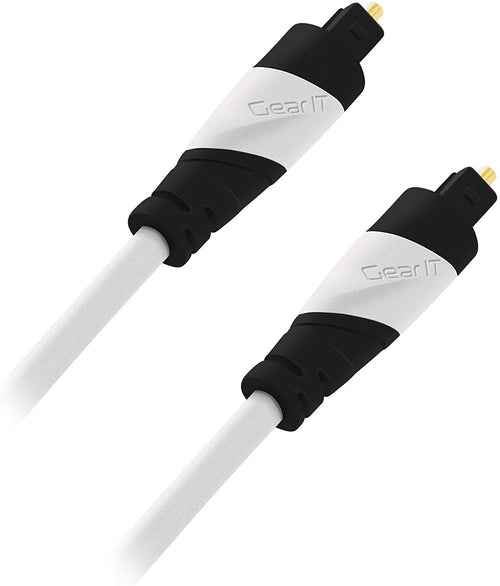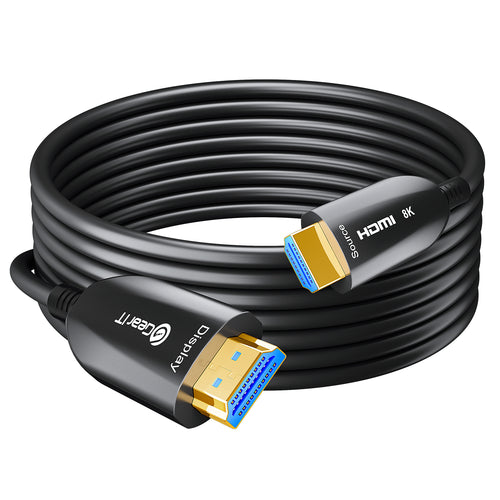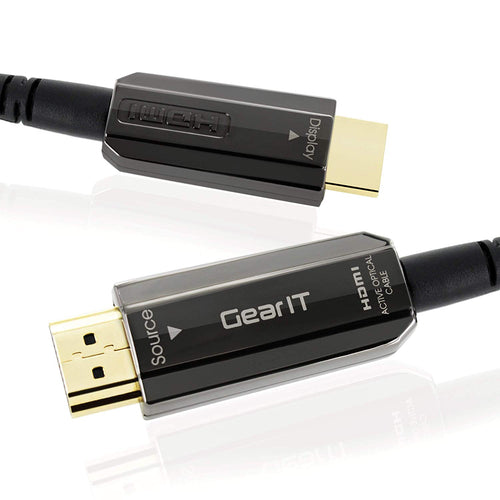TOSLINK and optical cables are essentially the same, using fiber optics to transmit high-quality digital audio signals without interference. They’re perfect for connecting soundbars, home theaters, and gaming consoles for crystal-clear audio.
Get the best TOSLINK and fiber optic cables from GearIT:
Shop GearIT now for interference-free audio and video with premium fiber optic cables! 🎧⚡
When it comes to connecting audio devices, the terms TOSLINK and optical often come up, leaving many people wondering about the differences between the two. Both options utilize light to transmit digital audio signals, but understanding their unique characteristics can help you make an informed choice for your audio setup. In this blog, we will explore TOSLINK and optical connections, highlighting their features, advantages, and potential drawbacks to help you determine which is best suited for your needs.
Whether you're setting up a home theater system, connecting a soundbar, or enhancing your gaming experience, selecting the right audio connection is crucial for achieving high-quality sound. By examining the distinctions between TOSLINK and optical cables, you'll gain insights into their performance and compatibility. Let’s get into the details and find out which audio connection is the right fit for you!
Looking for high-quality audio connections? Check out our selection of TOSLINK optical cables to ensure you get the best sound performance for your audio devices.
Understanding Digital Audio Fundamentals

Digital audio is the backbone of modern sound reproduction, relying on various technologies to transmit audio signals. Understanding the principles behind digital audio can help you make informed decisions about connections and equipment.
Digital Audio Signals and Connections
Digital audio signals represent sound as a series of numerical values, which can be transmitted between devices using various connections. The choice of connection impacts audio quality and system compatibility.
Common types of digital audio connections include:
- USB: Widely used for connecting computers and audio interfaces.
- HDMI: Carries both video and audio, often found in home theater setups.
- Toslink: Specifically designed for transmitting audio using optical technology.
Each connection has its advantages and disadvantages, affecting factors like latency, interference resistance, and overall audio fidelity.
Fiber Optic Technology in Audio
Fiber optic technology utilizes light pulses to transmit data, offering unique benefits for audio transmission. Unlike traditional copper cables, fiber optics are immune to electromagnetic interference (EMI) and radio frequency interference (RFI).
This immunity allows fiber optic cables to maintain high audio quality, particularly over long distances. The use of light for data transfer enables faster and more reliable communication of digital audio signals, enhancing your listening experience.
Key benefits include:
- Low signal degradation: Preserves audio quality over longer runs.
- Resistance to interference: Ensures a clearer sound without external disturbances.
- Compact size: Allows for more flexible installation options.
Toslink and Optical Audio Explained
Toslink is a specific type of optical connector that serves to transfer digital audio signals via fiber optic cables. Developed by Toshiba, Toslink is compatible with multiple devices, including TVs, soundbars, and gaming consoles.
Optical audio connections transmit audio in the form of light pulses, ensuring high fidelity with minimal loss of quality. This makes Toslink and similar optical connections excellent choices for serious audio applications.
When considering Toslink for your setup, note:
- Audio quality: High-quality transmission with minimal distortion.
- Distance capabilities: Effective for longer runs without degradation.
- Ease of use: Simple plug-and-play installation.
Toslink and optical connections offer a reliable way to enjoy superior sound in various audio environments.
Comparing Toslink and Optical Cables
When examining Toslink and optical cables, it's important to consider their physical makeup, audio transmission capabilities, and potential signal loss over distance. These factors will help you determine the most suitable option for your audio needs.
Physical Composition and Build
Toslink cables typically utilize plastic fiber construction, which is effective for transmitting audio signals. Plastic fibers are lightweight and flexible, making them easy to handle. However, they can have limitations in terms of signal clarity over longer distances.
In contrast, traditional optical cables often use glass fibers, specifically silica. Glass fibers provide superior light transmission, resulting in better audio quality and less signal degradation. While glass cables tend to be more expensive and less flexible, they are generally more durable and capable of maintaining quality over longer spans.
Audio Transmission Quality
Audio transmission quality hinges on the medium used in the cables. Toslink cables can deliver high-quality digital audio, but their plastic fibers may introduce some limitations, especially when dealing with complex audio formats like Dolby TrueHD.
Meanwhile, optical cables with glass fibers excel in transmitting uncompressed stereo and multi-channel audio, minimizing distortion. This quality makes glass-based optical cables more favorable for audiophiles looking for optimal performance in high-resolution sound systems. If you prioritize sound fidelity, investing in a glass optical cable could enhance your listening experience.
Cable Length and Signal Loss
Cable length significantly impacts signal loss in both Toslink and optical cables. For Toslink cables, the maximum effective length is often around 10 meters. Beyond this range, the risk of signal degradation increases, which can affect audio quality.
On the other hand, optical cables constructed from glass can often maintain signal integrity for distances up to 100 meters, depending on the specific design. Their superior ability to transmit light means that you can achieve longer runs without sacrificing the clarity of your audio. If you plan to distance your audio equipment, consider the length implications of each type of cable for uninterrupted performance.
Interested in broader options? Explore our range of fiber optic cables designed for various applications, delivering reliable performance and superior signal quality.
Applications and Compatibility
TOSLINK connections are widely used across various applications, particularly in home theater setups and gaming systems. Compatibility with diverse audio devices enhances your entertainment experience. Understanding how these connectors work helps ensure optimal performance in your audio configuration.
Home Theater and Gaming Systems
In home theater systems, TOSLINK is a popular choice for connecting receivers to audio sources like Blu-ray players. This optical connection allows for high-quality sound transmission without interference. The use of light for audio signal transfer makes it ideal for long cable runs without degradation.
For gaming systems, both consoles and PCs typically feature optical audio outputs. Using TOSLINK ensures immersive audio experiences, particularly in multi-channel setups. This connection type supports surround sound formats, enhancing your gaming experience by providing directional audio cues crucial for gameplay.
Connecting Audio Devices
When connecting various audio devices, TOSLINK offers excellent compatibility with a range of equipment. You can link CD players, soundbars, and smart TVs to receivers using optical cables, ensuring high-fidelity audio delivery. Most modern devices include TOSLINK ports, making integration straightforward.
In comparison to traditional audio cables, TOSLINK minimizes the risk of signal interference. This feature proves beneficial in setups with multiple electronic devices, such as media centers filled with game consoles and audio equipment. By selecting TOSLINK connections, you can achieve seamless integration with your favorite audio devices.
Audio Quality and Formats
When choosing between Toslink and optical audio connections, the aspects of audio quality and supported formats are crucial for your listening experience. Both formats excel in certain areas, but they cater to different needs based on your audio systems.
Multichannel Audio Support
Toslink and optical cables support various multichannel audio configurations. You can achieve stereo sound, as well as surround sound formats like Dolby Digital and DTS. This capability allows you to enjoy immersive audio experiences in home theater setups.
In addition to standard formats, these connections can also handle advanced multi-channel audio formats, including Dolby Atmos and DTS-HD Master Audio. Dolby TrueHD is another option that delivers lossless sound quality. That said, the effectiveness of these formats may depend on the specific sound system and receiver settings you use.
High-Resolution Audio Standards
Toslink and optical connections typically support high-resolution audio standards, transmitting signals that can maintain excellent sound fidelity. However, the total bandwidth may be limited compared to HDMI, which is often the preferred choice for high-resolution formats.
While optical cables can carry high-quality audio, they may not support the same maximum bitrates as HDMI. Consequently, Toslink may struggle with some truly high-resolution formats like DTS-HD or Dolby Atmos when compared to HDMI ARC connections. Be mindful of these limitations if your goal is to maximize sound quality in high-fidelity settings.
Advantages and Limitations
Understanding the advantages and limitations of Toslink and optical connections can help you make informed decisions about your audio setup. Key factors include interference susceptibility and the convenience of installation and use.
Evaluating Interference and Durability
Toslink connections utilize fiber optic technology, which inherently resists electromagnetic and electrical interference. This means you can expect clearer audio signals, even in environments with many electronic devices nearby. In contrast, traditional electrical connections can suffer from interference, impacting sound quality.
However, while fiber optic cables are resistant to interference, they are also more fragile. Careful handling is necessary to avoid damage. Bending or pulling the cable excessively can lead to breaks. Consider using protective sleeves or proper cable management to ensure durability over time.
Convenience in Installation and Use
Toslink cables are often user-friendly, requiring simple plug-and-play connections. This versatility allows for easy integration into various audio systems without the need for complicated setups. If you frequently change your connections, the lightweight design makes it easy to move components around.
On the downside, the fragility of Toslink cables can be a limitation. If you trim the cable length or require longer distances, signal degradation may occur. Always measure your needs to choose the appropriate length and consider optical extenders for longer runs.
Need a versatile solution? Discover our collection of HDMI fiber optic cables that provide excellent video and audio transmission for your home theater setup.
Conclusion
In conclusion, understanding the differences between TOSLINK and optical connections is essential for selecting the right audio solution for your setup. Both options offer unique benefits, and choosing the one that best fits your needs can significantly enhance your listening experience. Whether you're connecting a soundbar, home theater system, or other audio devices, knowing the advantages of each connection type will help you make an informed decision.
If you're ready to upgrade your audio setup, explore our selection of TOSLINK optical cables. With high-quality options available, you can ensure a reliable connection that delivers exceptional sound quality. Start shopping today and elevate your audio experience!
Frequently Asked Questions
Is TOSLINK the same as optical?
Yes, TOSLINK and optical refer to the same type of digital audio connection. TOSLINK, short for Toshiba Link, denotes a specific connector type that transmits audio using optical technology. The terms are often used interchangeably in audio discussions.
Can TOSLINK carry hi-res audio?
TOSLINK can carry high-resolution audio, but it has limitations. It typically supports formats like stereo and 5.1 surround sound. However, it may not handle advanced audio formats such as Dolby Atmos due to bandwidth constraints.
Can I use optical cable with TOSLINK?
Yes, you can use an optical cable with TOSLINK connections. The optical cable utilizes fiber optics to transmit audio signals, and TOSLINK refers to the connector type that fits into the optical audio port.
How do I connect my TOSLINK cable to my TV?
To connect a TOSLINK cable to your TV, locate the optical audio output port on the television. Insert one end of the TOSLINK cable into this port, and connect the other end to the optical input of your audio device, such as a soundbar or receiver.
What is the max resolution for TOSLINK?
The maximum resolution for TOSLINK is generally limited to 24-bit/96kHz audio. Although this is sufficient for many audio applications, it does not support the highest resolutions available in more advanced formats, such as those transmitted via HDMI.





















































